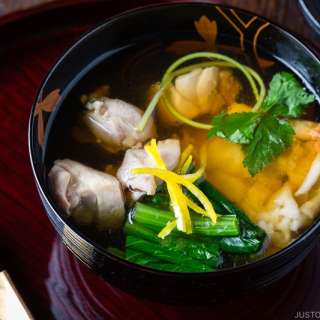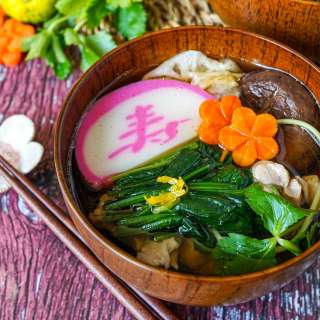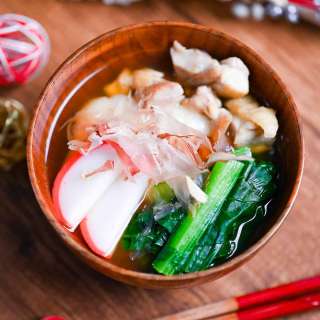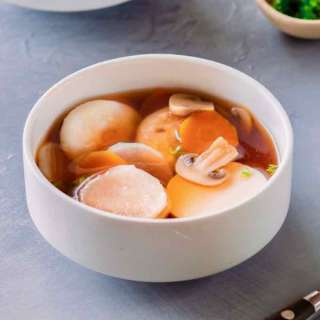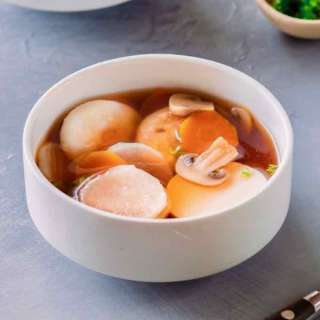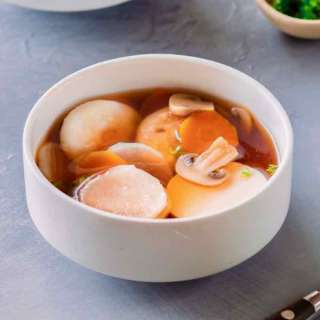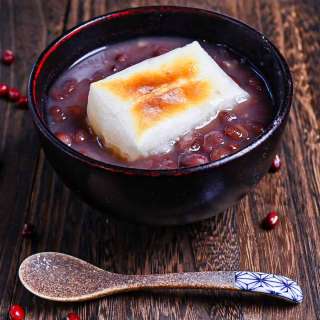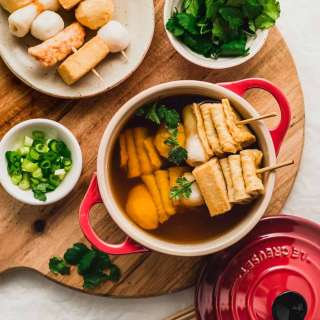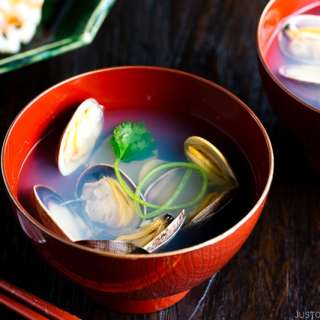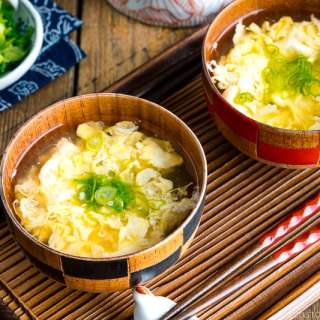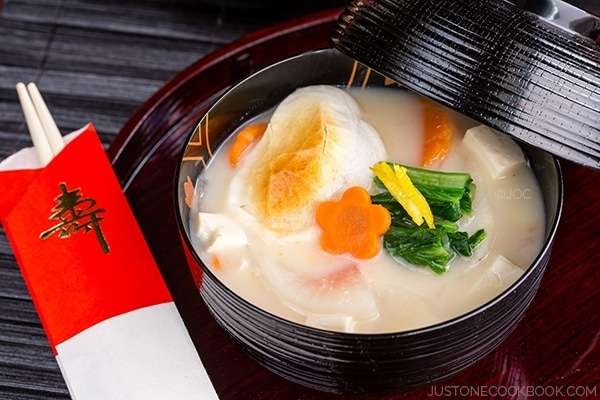
Ozoni (Japanese New Year Mochi Soup - Kansai Style)
User Reviews
4.5
165 reviews
Excellent

Ozoni (Japanese New Year Mochi Soup - Kansai Style)
Report
Kansai-style Ozoni is a miso-based mochi soup enjoyed for breakfast on New Year’s Day in Japan. It is one of the most iconic dishes of Osechi Ryori, or traditional Japanese New Year foods. This adaptation of my mom‘s plant-based recipe includes leafy green vegetables.
Share:
Ingredients
For the Kombu Dashi
- 1 piece kombu (dried kelp) (8 g; 3 x 3 inches, 8 x 8 cm per piece)
- 3 cups water
For the Ozoni
- 2 pieces taro (satoimo)
- 2 inches daikon radish
- 3 inches carrot
- 2 talks komatsuna (you can substitute spinach)
- 3–5 Tbsp Saikyo miso (Kyoto-style white miso) (sweeter than regular white miso)
- 7 oz soft/silken tofu (kinugoshi dofu)
- 4 pieces round mochi (rice cake)
For the Garnish
- yuzu zest (optional)
Instructions
- Before You Start: Please note that this recipe requires cold brewing the Kombu Dashi preferably overnight or at least 4–5 hours. In a pinch, you can steep it for 20–30 minutes and make Kombu Dashi on the stovetop.I recommend prepping this recipe the day before you plan to serve. The next day, reheat the soup and add the miso and mochi just before serving. For more helpful tips on planning your Japanese New Year feast, please read my A 5-Day Osechi Cooking Timeline blog post.
- Gather all the ingredients. Most Japanese recipes say to gently clean the kombu with a damp cloth. However, these days, kombu is pretty clean. Just make sure it doesn‘t have any mold spots and it‘s ready to use. Do not wash or wipe off the white powdery substance, as it has lots of umami.
To Make the Kombu Dashi
- To make the dashi stock, put 3 cups water and 1 piece kombu (dried kelp) in a large pot. For the best flavor, make cold brew Kombu Dashi and let it steep overnight on the counter (or in the refrigerator during warm weather). If you‘re short on time, you can steep it for at least 4–5 hours in the wintertime (or 2–3 hours in the summertime). In a pinch, soak the kombu for a minimum of 20–30 minutes and then make Kombu Dashi on the stovetop.
To Prepare the Ingredients
- Peel 2 pieces taro (satoimo) and slice it into rounds ⅛ inch (3 mm) thick. Soak the slices in a bowl of water to remove the slimy texture.
- Peel 2 inches daikon radish and slice it into rounds ⅛ inch (3 mm) thick. If it’s a large daikon, cut it in quarters lengthwise, then slice.
- Peel 3 inches carrot and slice it into rounds ⅛ inch (3 mm) thick. If you‘d like to decorate the soup with a carrot flower (called hanagiri), cut out some of the round slices into a floral shape. Keep the carrot rounds and flower-shaped pieces in different bowls, as you will cook them separately.
To Cook the Soup
- To the pot filled with the kombu dashi, add the satoimo (taro), daikon, and carrot rounds. Set the pot over medium-high heat and bring it to a boil. Right before the water reaches a boil, remove the kombu. Tip: If you leave the kombu in the pot, the stock will become slimy and bitter. With the spent kombu, you can make Simmered Kombu (Kombu Tsukudani) or Homemade Furikake (Rice Seasoning).
- Skim off the foam (from the satoimo) from the surface of the soup with a fine-mesh strainer. Lower the heat to medium low and cover with a lid slightly ajar. Simmer until the vegetables are tender. Add more water if too much liquid has evaporated.
- Meanwhile, cut 2 stalks komatsuna (or spinach) in half. Set a saucepan of water on the stove over medium-high heat. If you prepared carrot flower slices (optional), add them to the water. Bring the water to a boil. Then, add the komatsuna and cook until tender.
- Remove the komatsuna and carrot when they are tender and drain them. Cut the komatsuna into smaller pieces (1½ inches, 3 cm). Set these aside to serve as toppings later.
- While the taro and daikon continue to cook, prepare the yuzu zest (optional). Peel 2 or 3 thick strips of zest from the yuzu skin. Flip the pieces over and remove any white pith. Then, slice the strips of yuzu zest into thin julienned strips. Place on a small dish and set aside to serve as garnish later.
- Once the vegetables in the soup are tender, turn off the heat. Next, completely dissolve 3 Tbsp of the 3–5 Tbsp Saikyo miso (Kyoto-style white miso) into the soup. Taste the soup; if it needs more miso, add 1 Tbsp at a time until you’re satisfied with the flavor. (My family likes thick soup, so I tend to add more.) Once you‘re done stirring in the miso, cut 7 oz soft/silken tofu (kinugoshi dofu) into ½-inch (1.3-cm) cubes and gently add it to the soup without breaking it. Reheat the soup until it is just hot, turn off the heat, and keep it covered. Tip: Do not boil the soup because the miso will lose nutrients, flavor, and aroma.
- Once the soup and toppings are ready, place 4 pieces round mochi (rice cake) directly on the rack of a toaster oven and toast until puffy. You can also toast the mochi over an open flame, under a broiler, or in a frying pan.
To Serve
- Serve the soup in individual serving bowls. Add one piece of toasted mochi on top of the soup in each bowl. Serve immediately with the colorful toppings on the side.
To Store
- Remove the mochi and store the leftover soup in an airtight container or in the pot; keep in the refrigerator for up to 3 days. I recommend toasting and adding the mochi to the soup just prior to serving.
Nutrition Information
Show Details
Calories
222kcal
(11%)
Carbohydrates
45g
(15%)
Protein
7g
(14%)
Fat
2g
(3%)
Saturated Fat
1g
(5%)
Polyunsaturated Fat
1g
Monounsaturated Fat
1g
Sodium
515mg
(21%)
Potassium
526mg
(15%)
Fiber
4g
(16%)
Sugar
29g
(58%)
Vitamin A
5052IU
(101%)
Vitamin C
10mg
(11%)
Calcium
98mg
(10%)
Iron
1mg
(6%)
Nutrition Facts
Serving: 4Serving
Amount Per Serving
Calories 222 kcal
% Daily Value*
| Calories | 222kcal | 11% |
| Carbohydrates | 45g | 15% |
| Protein | 7g | 14% |
| Fat | 2g | 3% |
| Saturated Fat | 1g | 5% |
| Polyunsaturated Fat | 1g | 6% |
| Monounsaturated Fat | 1g | 5% |
| Sodium | 515mg | 21% |
| Potassium | 526mg | 11% |
| Fiber | 4g | 16% |
| Sugar | 29g | 58% |
| Vitamin A | 5052IU | 101% |
| Vitamin C | 10mg | 11% |
| Calcium | 98mg | 10% |
| Iron | 1mg | 6% |
* Percent Daily Values are based on a 2,000 calorie diet.
Genuine Reviews
User Reviews
Overall Rating
4.5
165 reviews
Excellent
Other Recipes
